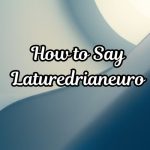Across online health groups, one phrase appears repeatedly — how to get rid of Laturedrianeuro. Yet, since the condition isn’t medically confirmed, most advice online remains speculative. The right approach is not panic or self-treatment but building mental clarity, restoring balance, and maintaining healthy routines.
Understand What “Get Rid of” Really Means
Since Laturedrianeuro isn’t listed in official medical records, there’s nothing specific to “cure.” Instead, “getting rid of” refers to reducing the symptoms people associate with it — tiredness, focus loss, or brain fog.
That goal can be reached through proper rest, nutrition, mental calm, and lifestyle alignment. Rather than chasing a name, it’s smarter to address the underlying habits that cause stress and mental overload.
Step One: Identify Everyday Triggers
Start by tracking what worsens your condition. Some online users link Laturedrianeuro-type feelings to stress, screen fatigue, and lack of hydration. Here’s how to recognize your triggers:
| Possible Trigger | Common Effect | Action Plan |
| Excessive screen time | Eye strain, brain fog | Follow the 20-20-20 rule |
| Poor sleep routine | Irritability, memory issues | Maintain fixed bedtime |
| Processed food | Low energy | Choose whole foods |
| Dehydration | Dizziness, confusion | Drink 2–3 liters daily |
| Emotional stress | Fatigue | Practice deep breathing |
Keeping a daily note of habits helps detect patterns.
Clean Up Your Daily Schedule
A chaotic schedule confuses the body’s rhythm. Simplify your day by following these core practices:
- Wake up early to match daylight cycles.
- Set three balanced meals instead of random snacking.
- Take hourly mini breaks from digital screens.
- Finish work two hours before bedtime to calm the brain.
- Sleep 7–8 hours without blue-light exposure.
Balancing your biological clock stabilizes hormone flow and prevents stress hormones from over-stimulating neural activity.
Adopt Brain-Friendly Nutrition
A healthy brain needs consistent fuel. Here are foods that naturally support focus and neural function:
- Omega-3 sources: salmon, walnuts, flaxseed oil.
- B-vitamin foods: eggs, brown rice, leafy greens.
- Magnesium-rich snacks: almonds, bananas, oats.
- Antioxidant fruits: blueberries, oranges, grapes.
- Hydrating drinks: coconut water, herbal teas.
Avoid alcohol, refined sugar, and heavy caffeine; they disturb brain-chemical balance.
Practice Mental Detox
Many who mention Laturedrianeuro describe symptoms similar to mental overload. Practicing cognitive rest restores clarity.
Simple ways include:
- Digital Fasting – One day a week, limit non-work screen time.
- Meditative Breathing – Inhale for four counts, hold for four, exhale for four.
- Mind Dump Journaling – Write thoughts freely before bed to unload tension.
- Sound Therapy – Listen to calm instrumental music during work intervals.
These techniques reduce cortisol levels and help your brain relax.
Gentle Physical Movement
Movement improves oxygen flow to the brain and regulates mood. You don’t need intense workouts; consistency matters more.
Recommended daily activities:
- Morning walk or light jog (20–30 minutes)
- Stretching or yoga before starting work
- Evening breathing walk to reset posture
- Weekend recreational sports for fun engagement
Movement also improves serotonin levels, helping balance mental state naturally.
Reset Sleep Quality
Poor sleep amplifies every cognitive issue. To recover faster, apply these adjustments:
| Habit | Result | Implementation |
| Sleep by 11 PM | Restores melatonin rhythm | Dim lights after 9 PM |
| No screens before bed | Prevents blue-light disruption | Read or meditate instead |
| Cool, dark room | Improves deep sleep | Use blackout curtains |
| Light dinner | Eases digestion | Eat before 8 PM |
Within two weeks of consistent sleep hygiene, mental clarity improves noticeably.
Rebuild Focus with Routine
After calming your body, strengthen attention span:
- Pomodoro cycles: 25 minutes focus, 5 minutes rest.
- Task batching: Group similar work to avoid context switching.
- Brain training: Crosswords or memory apps for 10 minutes daily.
- Reading habit: Non-fiction for cognitive engagement.
A balanced routine helps rebuild sharpness and dispels the fog linked with Laturedrianeuro claims.
Social and Emotional Recovery
Mental isolation magnifies confusion. Interact more with people who uplift you.
- Have meaningful conversation daily.
- Call friends instead of scrolling online.
- Participate in small community activities.
- Volunteer occasionally — helping others improves perspective.
Human connection reactivates emotional circuits that keep anxiety in control.

Stay Skeptical of Unverified “Cures”
Online spaces overflow with self-proclaimed solutions — powders, brain patches, or detox gadgets. Avoid them.
None have medical approval or testing.
Warning signs of fake remedies:
- Anonymous sellers or no contact info.
- Claims of instant recovery.
- Pricey subscription plans.
- No clinical references.
Your best recovery tool is routine, not expensive supplements.
Build a Prevention Mindset
Once symptoms improve, prevention keeps you stable. Follow this 5-point model:
| Area | Habit | Why it works |
| Body | Exercise 30 min/day | Circulates oxygen |
| Diet | Limit processed food | Reduces inflammation |
| Mind | Meditate 10 min/day | Calms stress cycle |
| Social | Talk openly | Strengthens support |
| Sleep | Keep schedule | Regulates hormones |
When to See a Doctor
Even though Laturedrianeuro spread lacks validation, some symptoms could signal real medical issues such as:
- Persistent dizziness or blurred vision
- Continuous fatigue despite rest
- Sudden memory gaps
- Speech difficulty
- Loss of coordination
Still any of these occur, consult a neurologist or mental-health specialist immediately. The issue might stem from an actual condition requiring diagnosis.
Home Environment Adjustments
Your surroundings directly influence mental health.
Small tweaks create calm and improve recovery speed:
- Keep a decluttered workspace to reduce overstimulation.
- Add indoor plants for freshness and oxygen.
- Maintain adequate lighting — not too harsh, not too dim.
- Play soothing background sounds (nature, rain, or lo-fi beats).
Comfort and minimal stress cues assist the brain’s self-repair process.
To get rid of Laturedrianeuro, focus on restoring body rhythm, clearing digital overload, and nurturing healthy habits. No pill or gadget replaces steady living.
By improving nutrition, sleep, exercise, and emotional stability, you’ll automatically remove the sensations people associate with this term. Consistency and simplicity beat any miracle claim.
True recovery begins when you stop chasing a label and start building balance every day.

